Economics Problem Set: Market Structures, Externalities, and Pricing
VerifiedAdded on 2023/04/21
|6
|1524
|485
Homework Assignment
AI Summary
This Economics assignment solution delves into various aspects of microeconomics, including market structures, pricing strategies, and externalities. It begins by addressing true/false and multiple-choice questions related to monopolistic competition, externalities, and market efficiency. The solution then explores sunk costs in a production scenario, analyzes demand and marginal revenue curves, and determines profit-maximizing price and quantity. Furthermore, the assignment examines optimal pricing strategies for software versions targeting different customer segments, considering willingness to pay and market size. Finally, it investigates game theory concepts, such as side payments and Nash equilibrium, in the context of strategic interactions between firms, and discusses the unique characteristics of the wedding industry, highlighting information asymmetry, monopolistic competition, and price discrimination. Desklib offers a wealth of similar solved assignments and past papers to aid students in their studies.
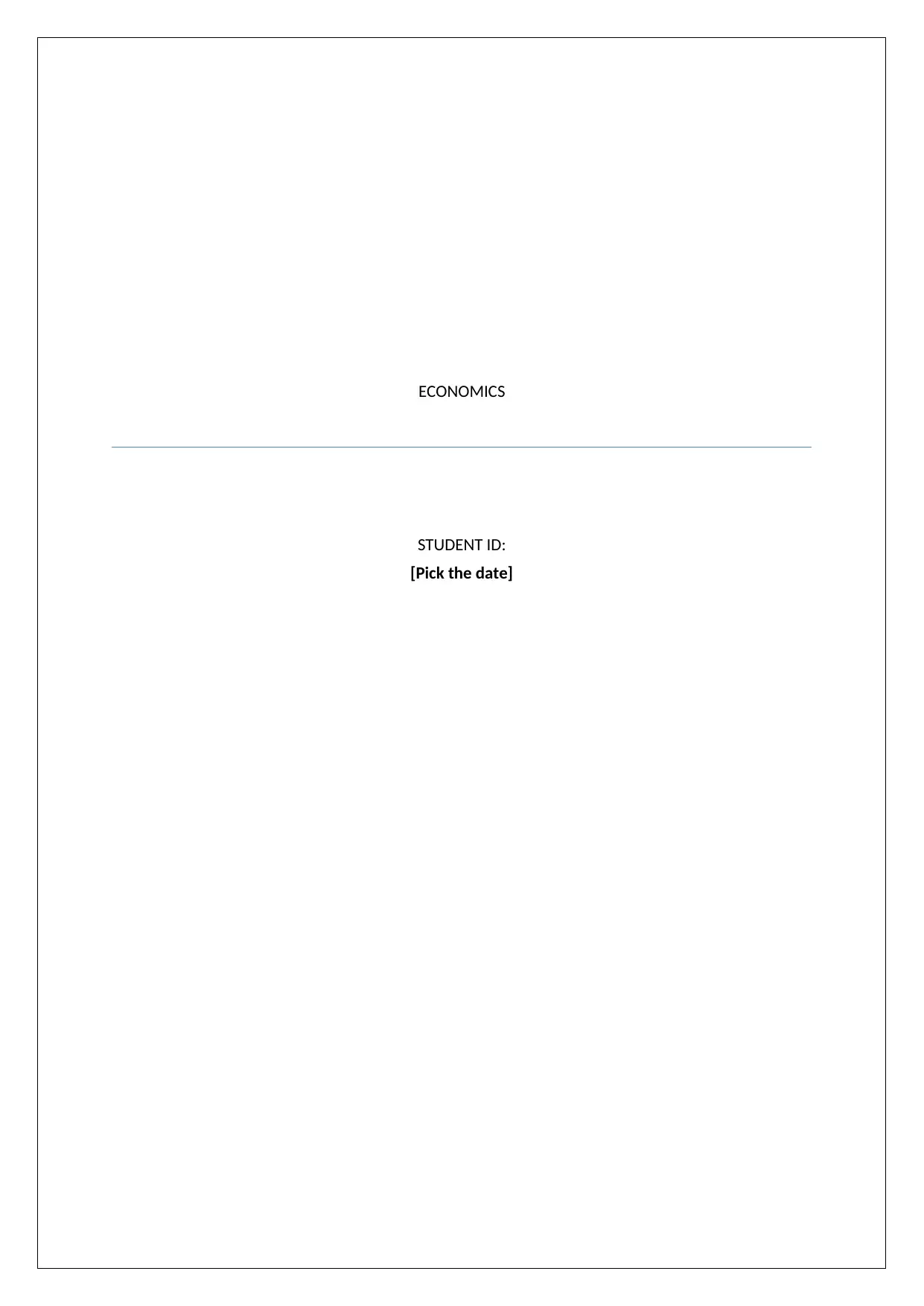
ECONOMICS
STUDENT ID:
[Pick the date]
STUDENT ID:
[Pick the date]
Paraphrase This Document
Need a fresh take? Get an instant paraphrase of this document with our AI Paraphraser
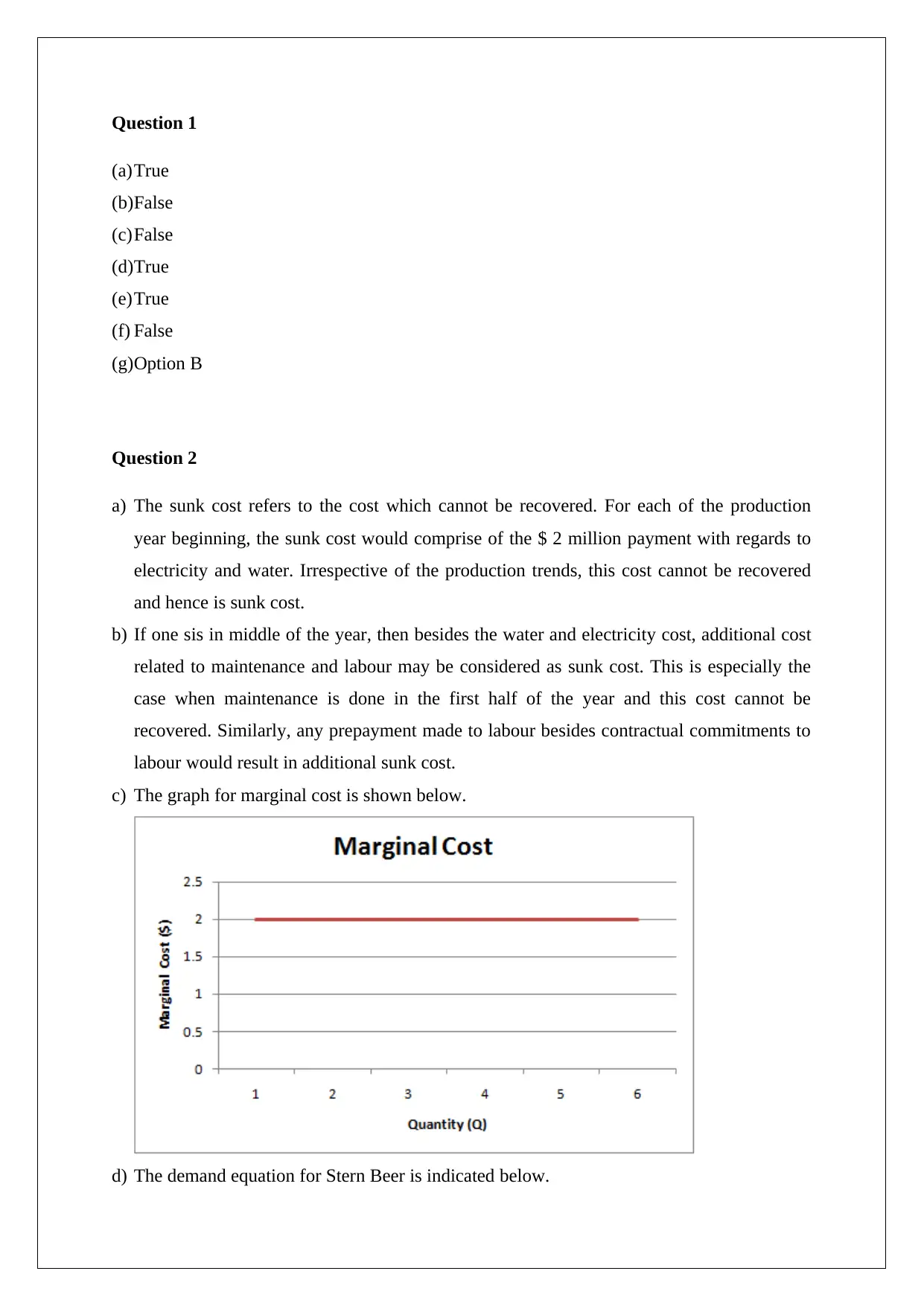
Question 1
(a)True
(b)False
(c)False
(d)True
(e)True
(f) False
(g)Option B
Question 2
a) The sunk cost refers to the cost which cannot be recovered. For each of the production
year beginning, the sunk cost would comprise of the $ 2 million payment with regards to
electricity and water. Irrespective of the production trends, this cost cannot be recovered
and hence is sunk cost.
b) If one sis in middle of the year, then besides the water and electricity cost, additional cost
related to maintenance and labour may be considered as sunk cost. This is especially the
case when maintenance is done in the first half of the year and this cost cannot be
recovered. Similarly, any prepayment made to labour besides contractual commitments to
labour would result in additional sunk cost.
c) The graph for marginal cost is shown below.
d) The demand equation for Stern Beer is indicated below.
(a)True
(b)False
(c)False
(d)True
(e)True
(f) False
(g)Option B
Question 2
a) The sunk cost refers to the cost which cannot be recovered. For each of the production
year beginning, the sunk cost would comprise of the $ 2 million payment with regards to
electricity and water. Irrespective of the production trends, this cost cannot be recovered
and hence is sunk cost.
b) If one sis in middle of the year, then besides the water and electricity cost, additional cost
related to maintenance and labour may be considered as sunk cost. This is especially the
case when maintenance is done in the first half of the year and this cost cannot be
recovered. Similarly, any prepayment made to labour besides contractual commitments to
labour would result in additional sunk cost.
c) The graph for marginal cost is shown below.
d) The demand equation for Stern Beer is indicated below.
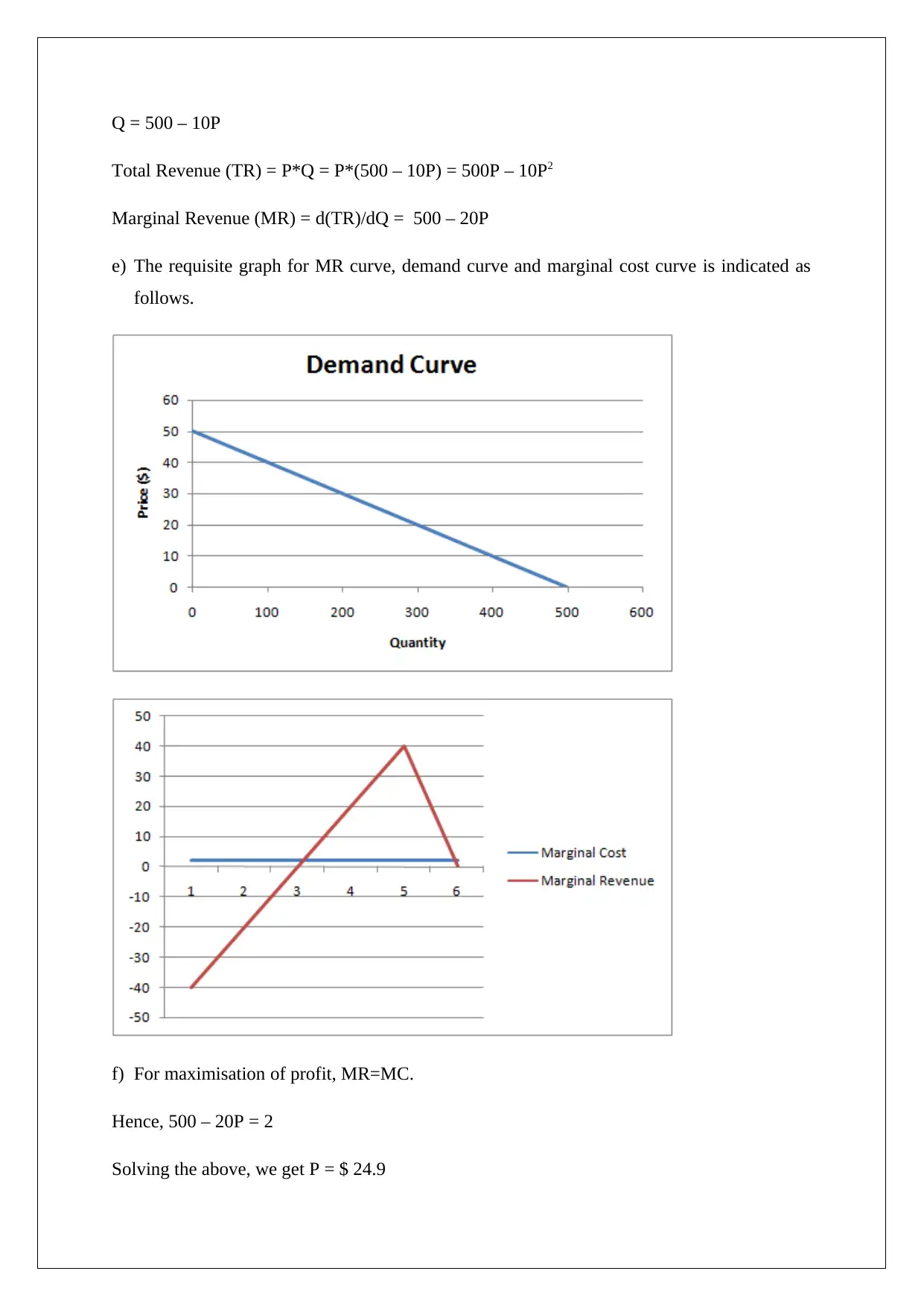
Q = 500 – 10P
Total Revenue (TR) = P*Q = P*(500 – 10P) = 500P – 10P2
Marginal Revenue (MR) = d(TR)/dQ = 500 – 20P
e) The requisite graph for MR curve, demand curve and marginal cost curve is indicated as
follows.
f) For maximisation of profit, MR=MC.
Hence, 500 – 20P = 2
Solving the above, we get P = $ 24.9
Total Revenue (TR) = P*Q = P*(500 – 10P) = 500P – 10P2
Marginal Revenue (MR) = d(TR)/dQ = 500 – 20P
e) The requisite graph for MR curve, demand curve and marginal cost curve is indicated as
follows.
f) For maximisation of profit, MR=MC.
Hence, 500 – 20P = 2
Solving the above, we get P = $ 24.9
⊘ This is a preview!⊘
Do you want full access?
Subscribe today to unlock all pages.

Trusted by 1+ million students worldwide
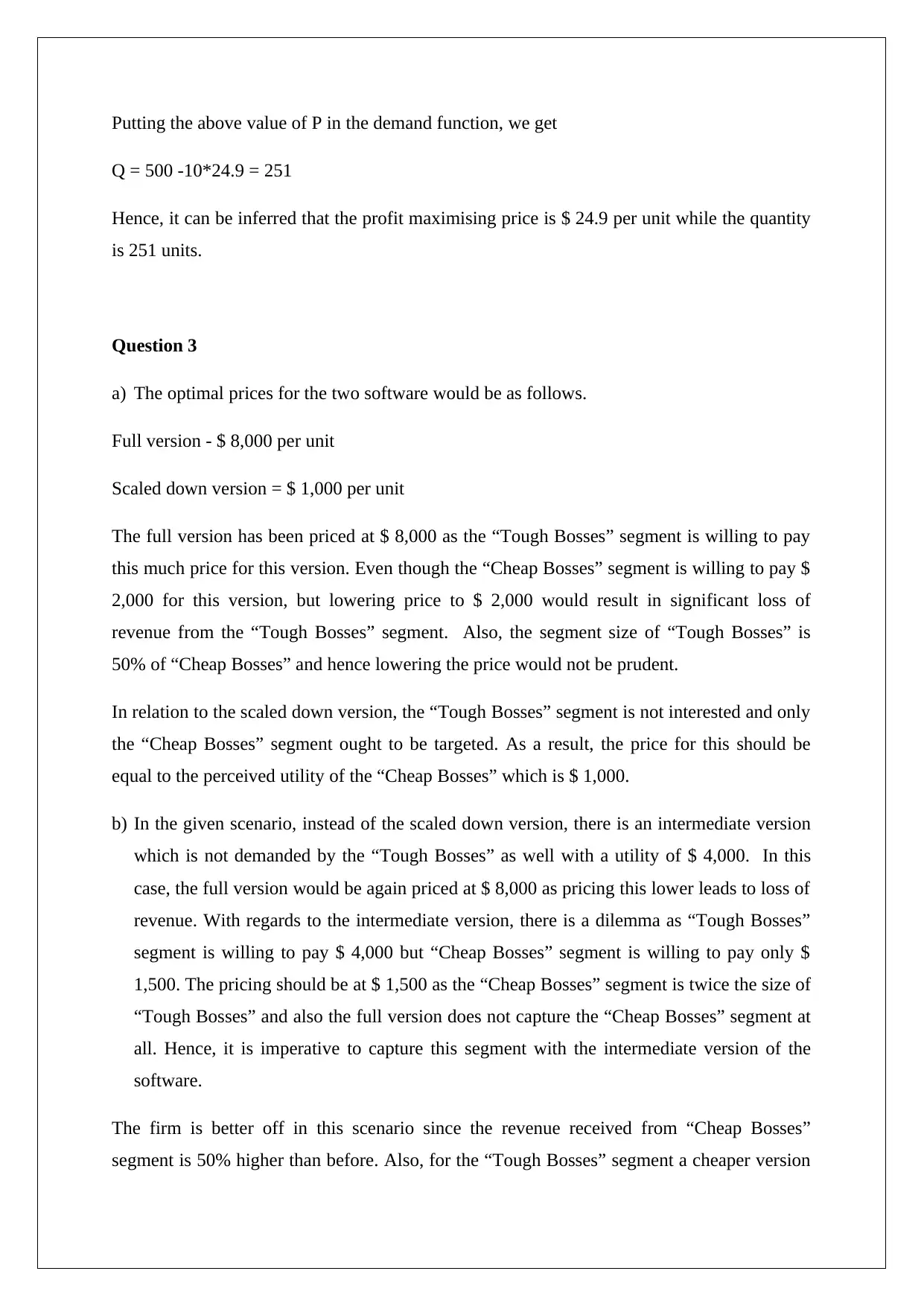
Putting the above value of P in the demand function, we get
Q = 500 -10*24.9 = 251
Hence, it can be inferred that the profit maximising price is $ 24.9 per unit while the quantity
is 251 units.
Question 3
a) The optimal prices for the two software would be as follows.
Full version - $ 8,000 per unit
Scaled down version = $ 1,000 per unit
The full version has been priced at $ 8,000 as the “Tough Bosses” segment is willing to pay
this much price for this version. Even though the “Cheap Bosses” segment is willing to pay $
2,000 for this version, but lowering price to $ 2,000 would result in significant loss of
revenue from the “Tough Bosses” segment. Also, the segment size of “Tough Bosses” is
50% of “Cheap Bosses” and hence lowering the price would not be prudent.
In relation to the scaled down version, the “Tough Bosses” segment is not interested and only
the “Cheap Bosses” segment ought to be targeted. As a result, the price for this should be
equal to the perceived utility of the “Cheap Bosses” which is $ 1,000.
b) In the given scenario, instead of the scaled down version, there is an intermediate version
which is not demanded by the “Tough Bosses” as well with a utility of $ 4,000. In this
case, the full version would be again priced at $ 8,000 as pricing this lower leads to loss of
revenue. With regards to the intermediate version, there is a dilemma as “Tough Bosses”
segment is willing to pay $ 4,000 but “Cheap Bosses” segment is willing to pay only $
1,500. The pricing should be at $ 1,500 as the “Cheap Bosses” segment is twice the size of
“Tough Bosses” and also the full version does not capture the “Cheap Bosses” segment at
all. Hence, it is imperative to capture this segment with the intermediate version of the
software.
The firm is better off in this scenario since the revenue received from “Cheap Bosses”
segment is 50% higher than before. Also, for the “Tough Bosses” segment a cheaper version
Q = 500 -10*24.9 = 251
Hence, it can be inferred that the profit maximising price is $ 24.9 per unit while the quantity
is 251 units.
Question 3
a) The optimal prices for the two software would be as follows.
Full version - $ 8,000 per unit
Scaled down version = $ 1,000 per unit
The full version has been priced at $ 8,000 as the “Tough Bosses” segment is willing to pay
this much price for this version. Even though the “Cheap Bosses” segment is willing to pay $
2,000 for this version, but lowering price to $ 2,000 would result in significant loss of
revenue from the “Tough Bosses” segment. Also, the segment size of “Tough Bosses” is
50% of “Cheap Bosses” and hence lowering the price would not be prudent.
In relation to the scaled down version, the “Tough Bosses” segment is not interested and only
the “Cheap Bosses” segment ought to be targeted. As a result, the price for this should be
equal to the perceived utility of the “Cheap Bosses” which is $ 1,000.
b) In the given scenario, instead of the scaled down version, there is an intermediate version
which is not demanded by the “Tough Bosses” as well with a utility of $ 4,000. In this
case, the full version would be again priced at $ 8,000 as pricing this lower leads to loss of
revenue. With regards to the intermediate version, there is a dilemma as “Tough Bosses”
segment is willing to pay $ 4,000 but “Cheap Bosses” segment is willing to pay only $
1,500. The pricing should be at $ 1,500 as the “Cheap Bosses” segment is twice the size of
“Tough Bosses” and also the full version does not capture the “Cheap Bosses” segment at
all. Hence, it is imperative to capture this segment with the intermediate version of the
software.
The firm is better off in this scenario since the revenue received from “Cheap Bosses”
segment is 50% higher than before. Also, for the “Tough Bosses” segment a cheaper version
Paraphrase This Document
Need a fresh take? Get an instant paraphrase of this document with our AI Paraphraser
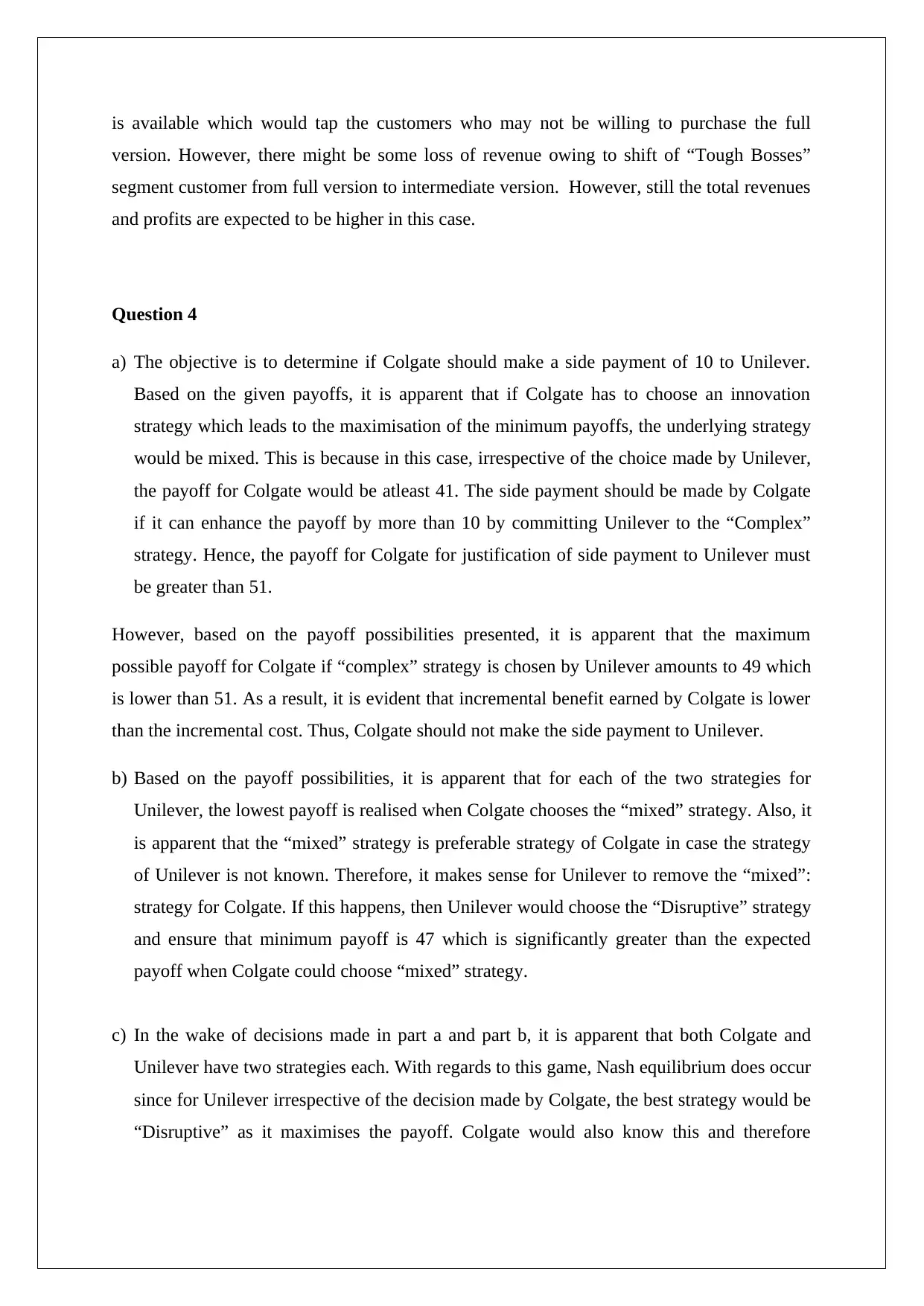
is available which would tap the customers who may not be willing to purchase the full
version. However, there might be some loss of revenue owing to shift of “Tough Bosses”
segment customer from full version to intermediate version. However, still the total revenues
and profits are expected to be higher in this case.
Question 4
a) The objective is to determine if Colgate should make a side payment of 10 to Unilever.
Based on the given payoffs, it is apparent that if Colgate has to choose an innovation
strategy which leads to the maximisation of the minimum payoffs, the underlying strategy
would be mixed. This is because in this case, irrespective of the choice made by Unilever,
the payoff for Colgate would be atleast 41. The side payment should be made by Colgate
if it can enhance the payoff by more than 10 by committing Unilever to the “Complex”
strategy. Hence, the payoff for Colgate for justification of side payment to Unilever must
be greater than 51.
However, based on the payoff possibilities presented, it is apparent that the maximum
possible payoff for Colgate if “complex” strategy is chosen by Unilever amounts to 49 which
is lower than 51. As a result, it is evident that incremental benefit earned by Colgate is lower
than the incremental cost. Thus, Colgate should not make the side payment to Unilever.
b) Based on the payoff possibilities, it is apparent that for each of the two strategies for
Unilever, the lowest payoff is realised when Colgate chooses the “mixed” strategy. Also, it
is apparent that the “mixed” strategy is preferable strategy of Colgate in case the strategy
of Unilever is not known. Therefore, it makes sense for Unilever to remove the “mixed”:
strategy for Colgate. If this happens, then Unilever would choose the “Disruptive” strategy
and ensure that minimum payoff is 47 which is significantly greater than the expected
payoff when Colgate could choose “mixed” strategy.
c) In the wake of decisions made in part a and part b, it is apparent that both Colgate and
Unilever have two strategies each. With regards to this game, Nash equilibrium does occur
since for Unilever irrespective of the decision made by Colgate, the best strategy would be
“Disruptive” as it maximises the payoff. Colgate would also know this and therefore
version. However, there might be some loss of revenue owing to shift of “Tough Bosses”
segment customer from full version to intermediate version. However, still the total revenues
and profits are expected to be higher in this case.
Question 4
a) The objective is to determine if Colgate should make a side payment of 10 to Unilever.
Based on the given payoffs, it is apparent that if Colgate has to choose an innovation
strategy which leads to the maximisation of the minimum payoffs, the underlying strategy
would be mixed. This is because in this case, irrespective of the choice made by Unilever,
the payoff for Colgate would be atleast 41. The side payment should be made by Colgate
if it can enhance the payoff by more than 10 by committing Unilever to the “Complex”
strategy. Hence, the payoff for Colgate for justification of side payment to Unilever must
be greater than 51.
However, based on the payoff possibilities presented, it is apparent that the maximum
possible payoff for Colgate if “complex” strategy is chosen by Unilever amounts to 49 which
is lower than 51. As a result, it is evident that incremental benefit earned by Colgate is lower
than the incremental cost. Thus, Colgate should not make the side payment to Unilever.
b) Based on the payoff possibilities, it is apparent that for each of the two strategies for
Unilever, the lowest payoff is realised when Colgate chooses the “mixed” strategy. Also, it
is apparent that the “mixed” strategy is preferable strategy of Colgate in case the strategy
of Unilever is not known. Therefore, it makes sense for Unilever to remove the “mixed”:
strategy for Colgate. If this happens, then Unilever would choose the “Disruptive” strategy
and ensure that minimum payoff is 47 which is significantly greater than the expected
payoff when Colgate could choose “mixed” strategy.
c) In the wake of decisions made in part a and part b, it is apparent that both Colgate and
Unilever have two strategies each. With regards to this game, Nash equilibrium does occur
since for Unilever irrespective of the decision made by Colgate, the best strategy would be
“Disruptive” as it maximises the payoff. Colgate would also know this and therefore
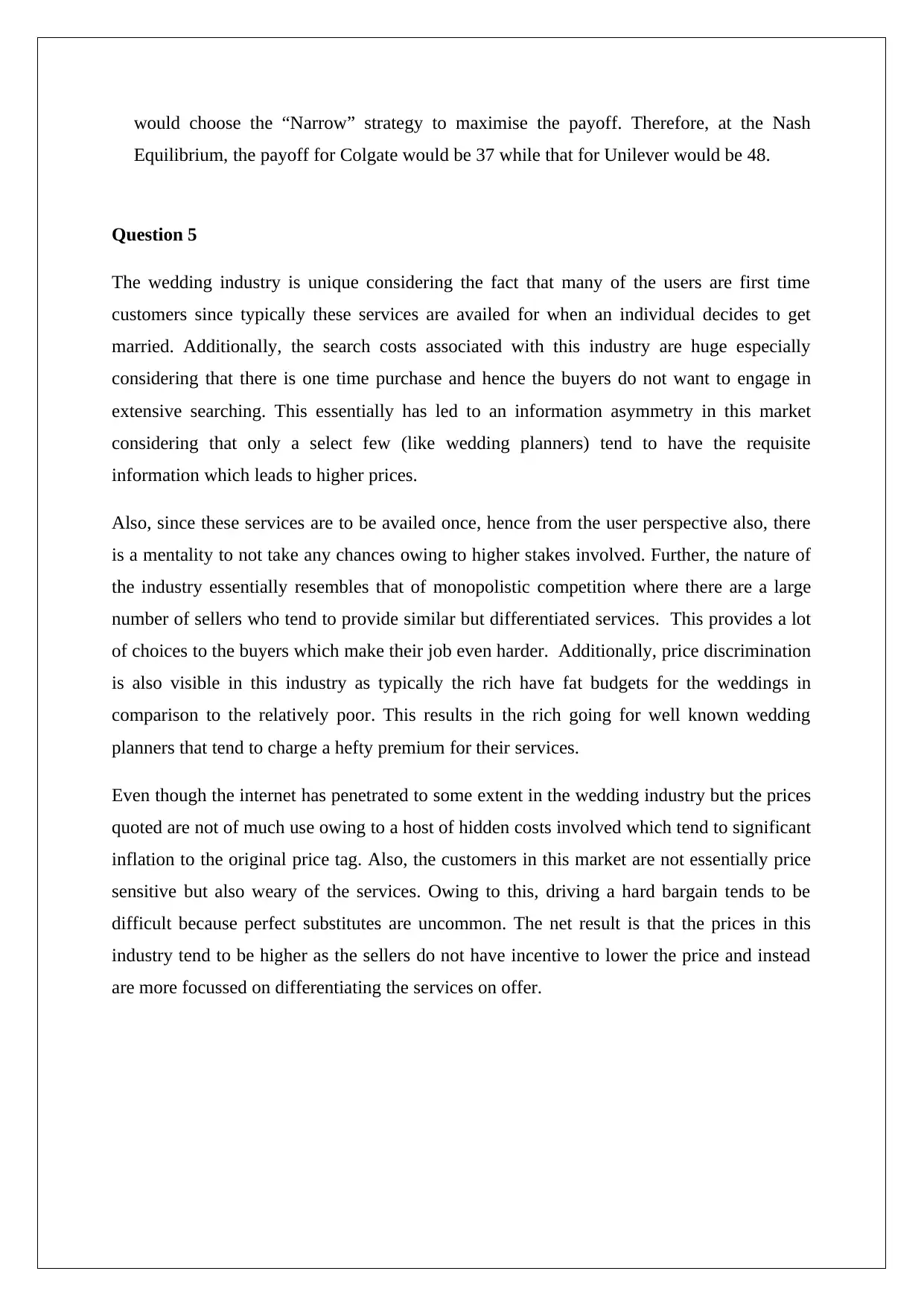
would choose the “Narrow” strategy to maximise the payoff. Therefore, at the Nash
Equilibrium, the payoff for Colgate would be 37 while that for Unilever would be 48.
Question 5
The wedding industry is unique considering the fact that many of the users are first time
customers since typically these services are availed for when an individual decides to get
married. Additionally, the search costs associated with this industry are huge especially
considering that there is one time purchase and hence the buyers do not want to engage in
extensive searching. This essentially has led to an information asymmetry in this market
considering that only a select few (like wedding planners) tend to have the requisite
information which leads to higher prices.
Also, since these services are to be availed once, hence from the user perspective also, there
is a mentality to not take any chances owing to higher stakes involved. Further, the nature of
the industry essentially resembles that of monopolistic competition where there are a large
number of sellers who tend to provide similar but differentiated services. This provides a lot
of choices to the buyers which make their job even harder. Additionally, price discrimination
is also visible in this industry as typically the rich have fat budgets for the weddings in
comparison to the relatively poor. This results in the rich going for well known wedding
planners that tend to charge a hefty premium for their services.
Even though the internet has penetrated to some extent in the wedding industry but the prices
quoted are not of much use owing to a host of hidden costs involved which tend to significant
inflation to the original price tag. Also, the customers in this market are not essentially price
sensitive but also weary of the services. Owing to this, driving a hard bargain tends to be
difficult because perfect substitutes are uncommon. The net result is that the prices in this
industry tend to be higher as the sellers do not have incentive to lower the price and instead
are more focussed on differentiating the services on offer.
Equilibrium, the payoff for Colgate would be 37 while that for Unilever would be 48.
Question 5
The wedding industry is unique considering the fact that many of the users are first time
customers since typically these services are availed for when an individual decides to get
married. Additionally, the search costs associated with this industry are huge especially
considering that there is one time purchase and hence the buyers do not want to engage in
extensive searching. This essentially has led to an information asymmetry in this market
considering that only a select few (like wedding planners) tend to have the requisite
information which leads to higher prices.
Also, since these services are to be availed once, hence from the user perspective also, there
is a mentality to not take any chances owing to higher stakes involved. Further, the nature of
the industry essentially resembles that of monopolistic competition where there are a large
number of sellers who tend to provide similar but differentiated services. This provides a lot
of choices to the buyers which make their job even harder. Additionally, price discrimination
is also visible in this industry as typically the rich have fat budgets for the weddings in
comparison to the relatively poor. This results in the rich going for well known wedding
planners that tend to charge a hefty premium for their services.
Even though the internet has penetrated to some extent in the wedding industry but the prices
quoted are not of much use owing to a host of hidden costs involved which tend to significant
inflation to the original price tag. Also, the customers in this market are not essentially price
sensitive but also weary of the services. Owing to this, driving a hard bargain tends to be
difficult because perfect substitutes are uncommon. The net result is that the prices in this
industry tend to be higher as the sellers do not have incentive to lower the price and instead
are more focussed on differentiating the services on offer.
⊘ This is a preview!⊘
Do you want full access?
Subscribe today to unlock all pages.

Trusted by 1+ million students worldwide
1 out of 6
Your All-in-One AI-Powered Toolkit for Academic Success.
+13062052269
info@desklib.com
Available 24*7 on WhatsApp / Email
![[object Object]](/_next/static/media/star-bottom.7253800d.svg)
Unlock your academic potential
Copyright © 2020–2025 A2Z Services. All Rights Reserved. Developed and managed by ZUCOL.